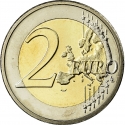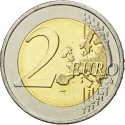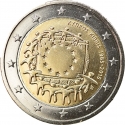You are about to finish your registration. Please check your mailbox (including spam folder). There should be a letter with a confirmation link. Check setting to make sure that your e-mail address is correct.
Send letter again
Obverse

|
The 12 stars of the European Union surround the Idol of Pomos, a prehistoric sculpture from the Cypriot village of Pomos. It dates back to the Chalcolithic period, circa the 30th century BC. The sculpture is on display in the Cyprus Archeological Museum in Lefkosia (Nicosia). ΚΥΠΡΟΣ KIBRIS |
|---|---|
Reverse

|
A geographical map of Western Europe spans the outer ring and inner core on the right side of the coin. The inscription 2 EURO is superimposed over the map of Europe, with the numeral “2” located in an open field representing the eastern Atlantic Ocean. 2 EURO |
| Edge |
The sequence "2 ΕΥΡΩ 2 EURO" repeated twice (2 EURO in Greek and Turkish). 2 ΕΥΡΩ 2 EURO 2 ΕΥΡΩ 2 EURO |
Swap now (4 offers)
Characteristics
| Material | Bi-Metallic |
| Ring | Cupronickel |
| Center | Nickel Brass |
| Weight | 8.5 g |
| Diameter | 25.75 mm |
| Thickness | 2.2 mm |
| Shape |
|
| Alignment | Medal |
| Mints |
Bank of Greece Mint of Finland
|
Related coins
10th Anniversary of the European Monetary Union and the Introduction of the Euro
10th Anniversary of Euro Coins and Banknotes
30th Anniversary of the Flag of Europe







